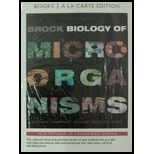Solutions for Brock Biology of Microorganisms, Books a la Carte Plus Mastering Microbiology with eText -- Access Card Package (14th Edition)
Browse All Chapters of This Textbook
Book Details
The authoritative #1 textbook for introductory majors microbiology, Brock Biology of Microorganisms continues to set the standard for impeccable scholarship, accuracy, and outstanding illustrations and photos. This book for biology, microbiology, and other science majors balances cutting edge research with the concepts essential for understanding the field of microbiology, including strong coverage of ecology, evolution, and metabolism.
The Fourteenth Edition seamlessly integrates the most current science, paying particular attention to molecular biology and how the genomic revolution has changed and is changing the field. This edition offers a streamlined, modern organization with a consistent level of detail and updated, visually compelling art program. Brock Biology of Microorganisms includes MasteringMicrobiology, an online homework, tutorial, and assessment product designed to improve results by helping you quickly master concepts both in and outside the classroom.
This program will provide a better teaching and learning experience-for you.
Sample Solutions for this Textbook
We offer sample solutions for Brock Biology of Microorganisms, Books a la Carte Plus Mastering Microbiology with eText -- Access Card Package (14th Edition) homework problems. See examples below:
More Editions of This Book
Corresponding editions of this textbook are also available below:
